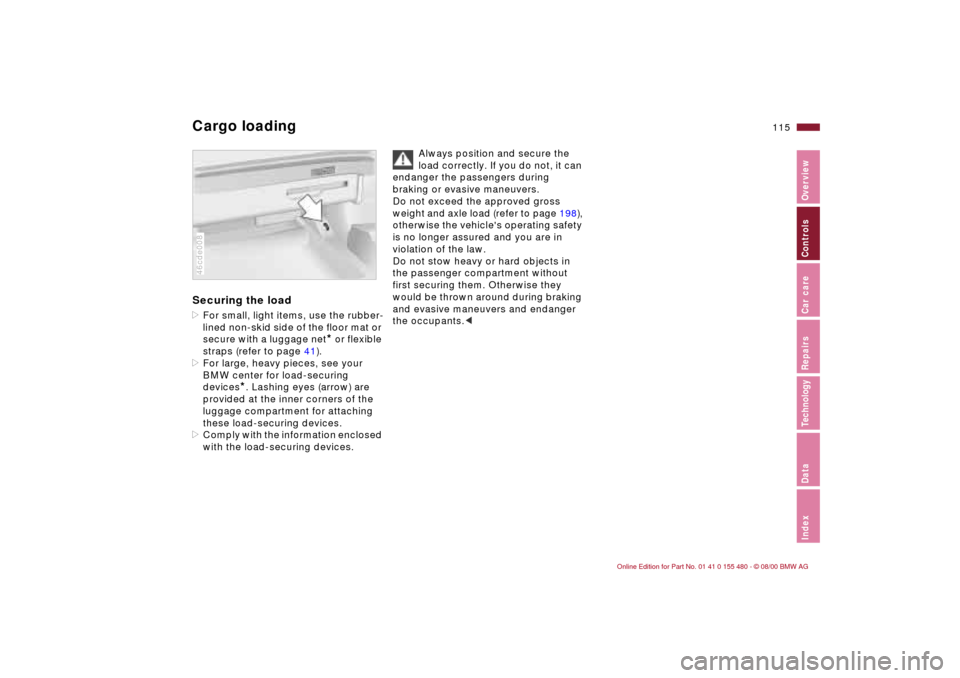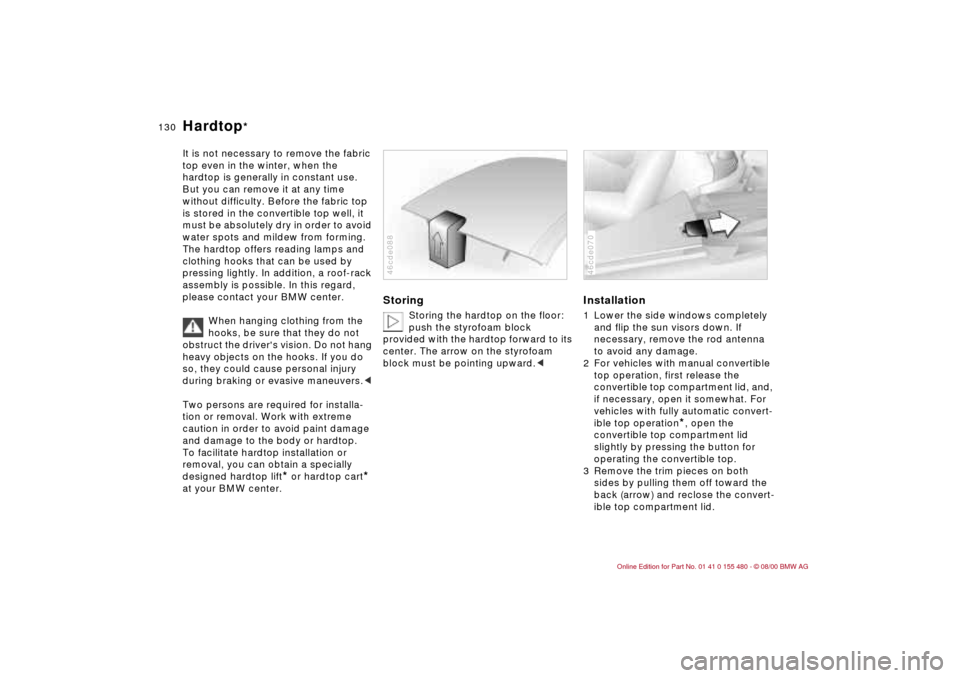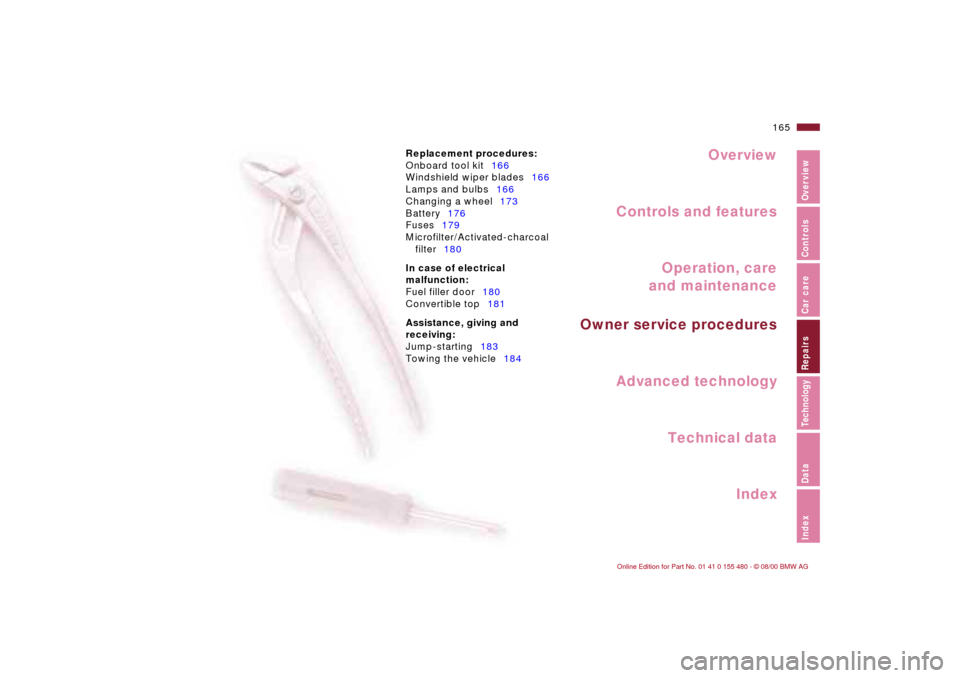2001 BMW 330Ci CONVERTIBLE tow
[x] Cancel search: towPage 115 of 215

115n
IndexDataTechnologyRepairsCar careControlsOverview
Cargo loadingSecuring the load >For small, light items, use the rubber-
lined non-skid side of the floor mat or
secure with a luggage net
* or flexible
straps (refer to page 41).
>For large, heavy pieces, see your
BMW center for load-securing
devices
*. Lashing eyes (arrow) are
provided at the inner corners of the
luggage compartment for attaching
these load-securing devices.
>Comply with the information enclosed
with the load-securing devices.
46cde008
Always position and secure the
load correctly. If you do not, it can
endanger the passengers during
braking or evasive maneuvers.
Do not exceed the approved gross
weight and axle load (refer to page 198),
otherwise the vehicle's operating safety
is no longer assured and you are in
violation of the law.
Do not stow heavy or hard objects in
the passenger compartment without
first securing them. Otherwise they
would be thrown around during braking
and evasive maneuvers and endanger
the occupants.<
Page 120 of 215

120n
To ensure that your vehicle provides
maximum economy throughout a long
service life, we request that you comply
with the following recommendations:
Engine and differentialUp to 1,200 miles (2,000 km):
Drive at varying engine and road
speeds, but do not exceed 4,500 rpm
or a speed of 100 mph (160 km/h):
Obey your local and state maximum
speed limits.
Always avoid using the full throttle or
"kickdown" position for the accelerator.
Once you have driven 1,200 miles
(2,000 km), engine speed and vehicle
speed can be gradually increased.
Follow the same break-in procedure if
either the engine or the differential is
replaced in the future.
TiresDue to technical factors associated
with their manufacture, tires do not
achieve their full traction potential until
an initial break-in period has elapsed.
For this reason drive cautiously during
the initial 200 miles (300 km).
Obey your local and state maximum
speed limits.
When the vehicle is operated on
wet or slushy roads, a wedge of
water may form between the tire and
the road surface. This phenomenon is
referred to as aquaplaning, or hydro-
planing, and can lead to partial or
complete loss of traction, vehicle
control and braking effectiveness.
Reduce your speed on wet roads.<
Brake systemApproximately 300 miles (500 km) must
elapse before the brake pads and discs
achieve the optimal pad-surface and
wear patterns required for trouble-free
operation and long service life later on.
To break-in the separate parking brake
drums, apply the parking brake lightly
when coasting to a standstill (at a traffic
signal, for instance), provided that
traffic conditions allow you to do so.
To avoid corrosion, repeat this proce-
dure from time to time.
The brake lamps do not come on
when the parking brake is set.
Vacuum for the brake system servo unit
on your BMW is available only when the
engine is running. When you move the
vehicle with the engine off Ð when
towing, for example Ð substantially
higher levels of pedal force will be
required to brake the vehicle.
(500 km). Engage the gears carefully
during the break-in period.
Break-in procedures
Page 121 of 215

121n
IndexDataTechnologyRepairsCar careControlsOverview
Brakes:
Do not drive with your foot resting
on the brake pedal. Even light but
consistent pedal pressure can lead to
high temperatures, brake wear, and
possibly to brake failure.
Aquaplaning:
When driving on wet or slushy roads,
reduce vehicle speed. If you do not, a
wedge of water may form between the
tires and the road surface. This
phenomenon is referred to as aqua-
planing or hydroplaning. It is character-
ized by a partial or complete loss of
contact between the tires and the road
surface. The ultimate results are loss of
steering and braking control.
Driving through water:
Do not drive through water on the road
if it is deeper than 1 ft (30 cm), and then
only at walking speed. Otherwise, the
vehicle's engine, the electrical systems
and the transmission may be damaged.
Clothes hooks (for the hardtop):
When suspending clothing from the
hooks, be sure that they will not
obstruct the driver's vision. Do not hang
heavy objects on the hooks. If you do
so, they could cause personal injury
during braking or evasive maneuvers.<
The catalytic converter reduces harmful
exhaust emissions.
It is designed for use with unleaded fuel
only. Even minute quantities of lead
would be enough to permanently
damage both the catalytic converter
and the system oxygen sensor.
To ensure efficient, trouble-free engine
operation and to avoid potential
damage:
>Be sure to comply with the scheduled
maintenance requirements.
>Fill the fuel tank well before it is
empty.
>Tow-start only when the engine is
cold. If you attempt to tow-start with
a warm engine, unburned residual
fuel in the catalytic converter could
ignite and cause damage. It is better
to jump-start the vehicle with outside
assistance.
>Avoid other situations in which the
fuel is not burned, or burns incom-
pletely, such as engaging the starter
frequently or for extended periods, or
repeated start attempts in which the
engine does not start (stopping and
restarting an engine which is running
properly does not present a problem).
Never allow the engine to run with
any of the spark plug cables discon-
nected.Be sure to comply with the
preceding instructions to prevent
unburned fuel from reaching the cata-
lytic converter. If you do not, the cata-
lytic converter could respond by
overheating, leading to serious
damage.
Very high temperatures occur in any
vehicle equipped with a catalytic
converter. Heat shields are installed
adjacent to some sections of the
exhaust system. Never remove these
shields; do not apply undercoating to
their surfaces. When driving, standing
at idle, and parking the vehicle, take
extra care to avoid contact between the
exhaust system and flammable mate-
rials (grass, hay, leaves, etc.). Such
contact could lead to a fire, resulting in
serious personal injury and property
damage.<
Driving notes Catalytic converter
Page 130 of 215

130n
Hardtop
*
It is not necessary to remove the fabric
top even in the winter, when the
hardtop is generally in constant use.
But you can remove it at any time
without difficulty. Before the fabric top
is stored in the convertible top well, it
must be absolutely dry in order to avoid
water spots and mildew from forming.
The hardtop offers reading lamps and
clothing hooks that can be used by
pressing lightly. In addition, a roof-rack
assembly is possible. In this regard,
please contact your BMW center.
When hanging clothing from the
hooks, be sure that they do not
obstruct the driver's vision. Do not hang
heavy objects on the hooks. If you do
so, they could cause personal injury
during braking or evasive maneuvers.<
Two persons are required for installa-
tion or removal. Work with extreme
caution in order to avoid paint damage
and damage to the body or hardtop.
To facilitate hardtop installation or
removal, you can obtain a specially
designed hardtop lift
* or hardtop cart
*
at your BMW center.
Storing
Storing the hardtop on the floor:
push the styrofoam block
provided with the hardtop forward to its
center. The arrow on the styrofoam
block must be pointing upward.<
46cde088
Installation1 Lower the side windows completely
and flip the sun visors down. If
necessary, remove the rod antenna
to avoid any damage.
2 For vehicles with manual convertible
top operation, first release the
convertible top compartment lid, and,
if necessary, open it somewhat. For
vehicles with fully automatic convert-
ible top operation
*, open the
convertible top compartment lid
slightly by pressing the button for
operating the convertible top.
3 Remove the trim pieces on both
sides by pulling them off toward the
back (arrow) and reclose the convert-
ible top compartment lid.
46cde070
Page 132 of 215

132n
Information for your safetyThe factory-approved radial tires are
matched to the vehicle and have been
selected to provide optimum safety and
driving comfort on your vehicle.
It is not merely the tire's service life, but
also driving comfort and Ð above all
else Ð driving safety that depend on the
condition of the tires and the mainte-
nance of the specified tire pressure.
Incorrect inflation pressure is a frequent
cause of tire damage. It also signifi-
cantly influences the roadholding ability
of your BMW.
Be sure to check the tire inflation
pressure Ð including the space-
saver spare tire Ð on a regular basis, i.e.
at least twice a month and before
beginning a longer trip. Refer to
page 28. If this is not done, incorrect
tire pressures can cause driving insta-
bility and tire damage, ultimately
resulting in an accident.<
Tire tread Ð tire damageInspect your tires frequently for tread
wear, signs of damage and for foreign
objects lodged in the tread. Check the
tread depth.
Tread depth should not be allowed to
go below 0.12 in (3 mm), even though
the legally specified minimum tread
depth is only 0.063 in (1.6 mm). At a
tread depth of 0.063 in (1.6 mm), tread
depth indicators (arrow) in the tread-
groove base indicate that the legally-
permissible wear limit has been
reached. Below 0.12 in (3 mm) tread
depth, there is an increased risk of
aquaplaning, even at relatively
moderate speeds and with only small
amounts of water on the road.390de331
Do not drive on a deflated (flat)
tire. A flat tire greatly impairs
steering and braking response, and can
lead to complete loss of control over
the vehicle.
Avoid overloading the vehicle so that
the permitted load on the tires is not
exceeded. Overloading can lead to
overheating and increases the rate at
which damage develops inside the
tires. You could have a blowout as a
result.
Unusual vibrations encountered during
normal vehicle operation can indicate
tire failure or some other vehicle defect.
This is also true for irregularities in the
vehicle's handling characteristics, such
as a pronounced tendency to pull to the
left or right. Should this occur, respond
by immediately reducing your speed.
Proceed carefully to the nearest BMW
center or professional tire center, or
have the vehicle towed in to have it and
its tires inspected.
Tire damage (up to and including blow-
outs) can endanger the lives of both the
vehicle occupants and other road
users.<
Tire inflation pressure Tire condition
Page 145 of 215

145n
IndexDataTechnologyRepairsCar careControlsOverview
Engine oilChecking the oil level 1 Park the vehicle on a level surface.
2 Shut the engine off after it has
reached normal operating tempera-
ture.
3 After approx. 5 minutes, pull the
dipstick out and wipe it off with a
clean lint-free cloth, paper towel, or
similar material.
4 Carefully push the dipstick all the way
into the guide tube and pull it out
again.
5 The oil level should be between the
two marks on the dipstick.
As with fuel economy, oil consumption
is directly influenced by your driving
style and vehicle operating conditions.462de244
The oil volume between the two marks
on the dipstick corresponds to approx.
1.1 US quarts (1 liter). Do not fill beyond
the upper mark on the dipstick. Excess
oil will damage the engine.460de189
To add oil Wait until the level has dropped to just
above the lower mark before adding oil.
However, never let the oil drop below
the lower mark.
BMW engines are designed to
operate without oil additives; the
use of additives could lead to damage
in some cases. This is also true for the
manual transmission, the automatic
transmission, the differential and the
power steering.<462de245
Page 157 of 215

157n
IndexDataTechnologyRepairsCar careControlsOverview
Cleaning and care of the convertible topCareThe appearance and life of the convert-
ible top are highly dependent on its
proper care and operation. You should
pay particular attention to the following
instructions if your car has a light-
colored top.
Protect the vehicle from exposure to
intense sunlight whenever possible by
parking it in the shade. This will help to
prevent the paint, rubber and fabric-
covered parts from being worn out.
Never stow the convertible top in the
convertible top compartment when it is
wet, dirty or frozen, since this can
cause mildew stains and chafe marks.
To prevent mildew stains, do not keep
the convertible top enclosed in the
convertible top compartment for any
extended period of time.
If the vehicle will be parked for lengthy
periods in an enclosed space, be sure
that the convertible top is dry and that
there is adequate ventilation.
Clean off bird droppings immediately,
since they attack the convertible top
and cause the rubber seals to swell due
to their caustic characteristics.Besides water, treat rubber seals only
with talcum powder, rubber care prod-
ucts or silicone spray, particularly when
they feel dry or tend to stick.
Eliminate noises such as squeaks with
lubricant spray.
Depressions and discoloration may
occur in the convertible top as a result
of improper maintenance and cleaning
or due to loading from excessive use.
The convertible top and its seams may
also develop leaks. These occurrences
are not covered by the warranty. For
repairs, please consult your BMW
center.
Washing your carYou can wash your BMW at an auto-
matic car wash. Brushless systems are
preferable.
If a brushless car wash is unavailable
and a brush car wash must be used,
modern systems with soft brushes are
preferable. Do not select the wax finish
option. The small amount of beading
wax always used in automatic car
washes will not harm your vehicle's
finish.
In the case of more extensive dirt,
which is definitely visible on light-
colored top materials, clean the top
with the BMW Convertible Cleaning
Set. Please proceed as follows:
Spray the convertible top with the
cleaning agent and then rub with a
well-dampened sponge using circular
motions until a foam develops. Then
you can finish washing the vehicle in an
automatic car wash. After washing your
vehicle 3 to 5 times, you should treat
the convertible top with a special
convertible top impregnating spray.
Please follow the instructions on the
spray can.
Page 165 of 215

Overview
Controls and features
Operation, care
and maintenance
Owner service procedures
Technical data
Index Advanced technology
165n
IndexDataTechnologyRepairsCar careControlsOverview
Replacement procedures:
Onboard tool kit166
Windshield wiper blades166
Lamps and bulbs166
Changing a wheel173
Battery176
Fuses179
Microfilter/Activated-charcoal
filter180
In case of electrical
malfunction:
Fuel filler door180
Convertible top181
Assistance, giving and
receiving:
Jump-starting183
Towing the vehicle184
Repairs